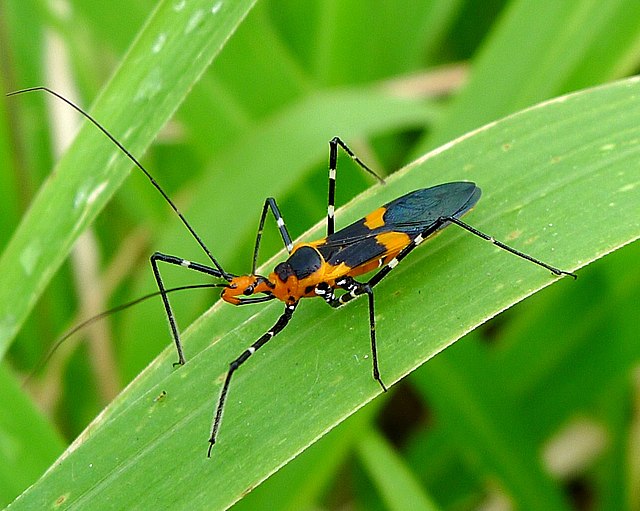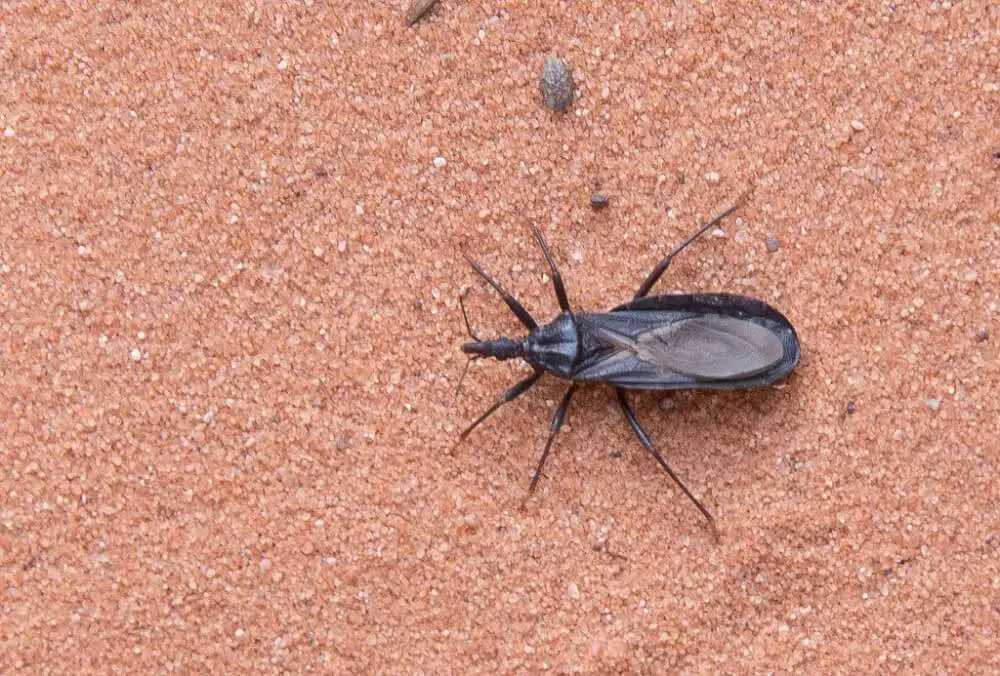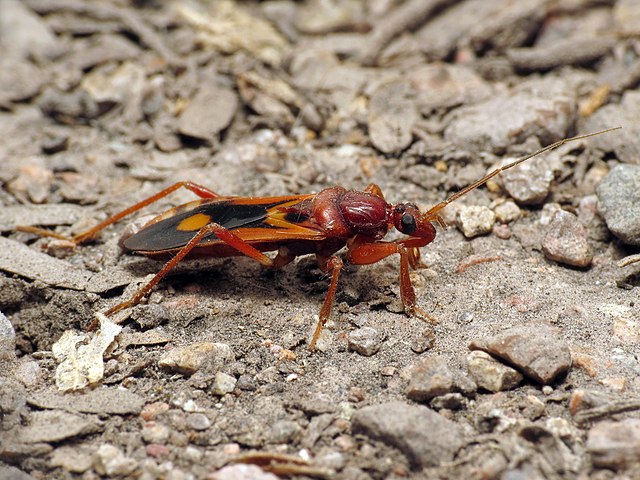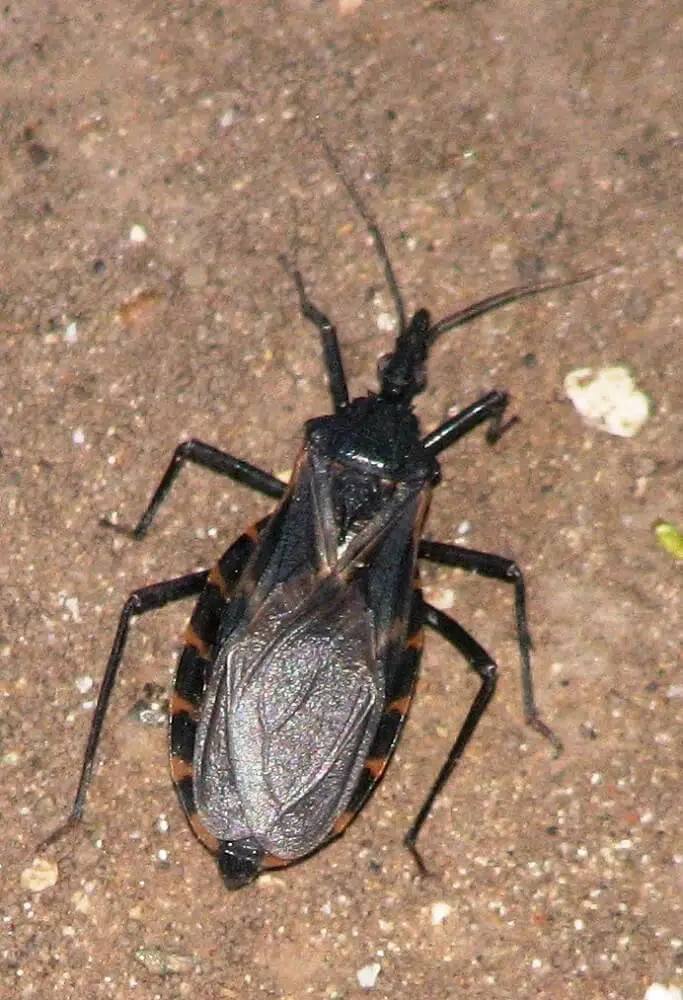Assassin bugs (Reduviidae) are mostly known for inflicting painful bites on humans. These types are also known for sucking the blood of humans and animals.
There are numerous species of assassin bugs in the US that share some characteristics such as having a long beak. All assassin bugs have a curved beak. This beak is used for feeding.
Table of Contents
What are Assassin Bugs?
Part of the Heteroptera genus, Assassin bugs are comprised of more than 7.000 species of bugs.
Many of these bugs are predators while a good portion of them are also known for sucking the blood of animals and even the blood of humans given the chance.
Assassin Bug Identification

The easiest way to identify assassin bugs is by their long narrow head. This head shape makes assassin bugs look like bugs with a neck. A second important characteristic is the presence of the curved beak.
Assassin bugs are known to grow more than 1 inch. However, various species of assassin bugs can be as small as 0.2 inches or as large as 1.6 inches. Their size resembles the size of roaches.
What do Assassin Bug Look Like
Assassin bugs have a colored body. They can be black, brown, red, green, yellow, or orange. Most assassin bugs have a round body shape which may or may not be elongated.
Behavior and Diet
Many species of assassin bugs exhibit predatory behavior. Their capacity to insert saliva in prey often allows them to consider prey that is a few times larger than themselves.
Assassin bugs can insert enzymes with saliva into prey. This liquefies the prey allows the bugs to eat them up easier. Assassin bugs have a wide diet which includes the following.
- Larvae
- Caterpillars
- Beetles
- Insects
- Worms
- Blood
Habitat and Distribution
There are thousands of species of assassin bugs, each with its habitat preferences. These types of bugs are common in the following locations.
- Woodlands
- Rainforests
- Rocky areas
- Sand-soil areas
- Gardens
- Crops
- Meadows
- Animal shelters
Types of Assassin Bugs
The following species are the most common from the thousands of various assassin bugs. These are species found in the US.
1. North American Wheel Bug

The North American Wheel Bug (Arilus cristatus) is one of the largest species of bugs in the US as it grows to an average of 1.6 inches.
This is the only species of Wheel bug found in the country. This species is known for a type of armored-like pronotal segment.
North American Wheel Bugs have a gray-brown body but they’re generally hard to see since these bugs run away when they see people.
The bugs aren’t shy when it comes to finding food and mating.
Bugs of the species are known to use their long beaks to insert saliva into prey to paralyze it and drink its liquids.
These bugs are also among the multiple assassin bugs displaying cannibalistic behavior. Nymphs North America Wheel bugs often each other.
Female North American Wheel Bugs can eat males soon after mating for their nutritional value.
Bugs of this species are common areas with sunflower or on crops where they’re seen as beneficial as they tend to eat many types of insects that attack crops.
2. Pale Green Assassin Bug

This type of assassin bug (Zelus luridus) is known for its green think body. Pale Green Assassin bugs don’t have wings but they know how to hunt.
Bugs of this species are known for eating insects that are found around trees. They use 2 main hunting techniques to catch them.
Waiting around making the most of its green camouflaging color is the preferred method Pale Green Assassin Bugs use to get insects.
They also go out of their way to hunt down insects whenever they can’t find food.
These bugs are also known for laying eggs in high numbers. Up to 50 eggs are laid at a time. These eggs are recognized by their brown color.
Most eggs are laid on leaves.
3. Milkweed Assassin Bug

The Milkweed Assassin Bug (Zelus longipes) is common in the US, particularly in Southern states. They are identified by a short 18mm body with orange-black or brown-black coloring and black legs.
These bugs are common across multiple types of crops as they feed on the insects living on these crops.
Milkweed Assassin bugs are found around cornfields in the Southern US where they specifically hunt Fall armyworm grey worms.
Milkweed Assassin bugs have a distinct method of catching insects. They lay out a sticky substance on leaves that trap insects for them to consume.
4. Leafhopper Assassin Bug

Leafhopper Assassin Bugs (Zelus renardii) are identified by their green and brown body color. These bugs are common in agricultural fields where they’re beneficial as they eat many infesting insects.
Bugs of the species eat bugs that are harmful to cotton, soybean, and fruits.
These bugs can also bite people resulting in pain that takes a few minutes to subside.
Sticky traps are used by these assassin bugs to catch insects. They also use pre-oral digestion techniques to drink the liquefied body of their prey.
5. Jagged Ambush Bug

Jagged Ambush Bugs (Phymata americana) are among the most common types of assassin bugs that live on flowers. These yellow bugs are known for preferring the most colorful flowers where they sit on awaiting prey.
As bugs that live on flowers, Jagged Ambush bugs are mostly tied to eating other insects that are attracted to flowers.
This includes many types of bees. Moths are often consumed by these bugs as well as they tend to hover around flowers to consume pollen.
These bugs are common in flower fields, particularly around woodlands. They are sometimes seen on farms that have a wider range of flowers or blossoming plants.
6. Orange Assassin Bug

This species of bug (Pselliopus barberi) is identified by its mostly orange body. Its round elongated body has black lines and black stripes across its legs. These bugs may appear slightly amber in certain regions.
Orange Assassin Bugs are part of a few hundred types of species of assassin bugs found in the US.
It’s often found around trees, especially on the bark where it may not be as easy to spot by its prey. Orange Assassin bugs consume a wide range of insects that come in their range.
7. Phymata fasciata

This type of assassin bug is a very potent predator. It’s one of the few types of bugs of this genus that can take on prey a few times larger than its 1-inch body.
Bugs of these species are tan or brown. They have a body that appears wrinkly, often confused with leaves or tree bark.
This allows these bugs to remain undetected on flowers or trees where many types of insects approach them unknowingly.
Bugs of the species have a very potent bite.
They often eat powerful large insects such as wasps, hornets, and bees such as bumblebees.
However, these bugs cannot be seen as truly beneficial to any type of habitat as they also eat honeybees.
8. Pennsylvania Ambush Bug

These bugs (Phymata pennsylvanica) are the most common types of ambush bugs in the Eastern US. They grow to 12mm and they are known for having a brown color with excellent camouflage traits.
Bugs of this genus are sometimes compared with brown leaves given their flattened appearance.
These bugs feed on a wide range of insects and they do this by playing a waiting game. They sit on flowers for hours at a time waiting for the next meal.
Common East of the Mississippi River, these bugs are some of the most successful bee and butterflies predators.
9. Apiomerus spissipes

Common in Central and North America, this species of assassin bug has a tricolored body. It has a brown, red, and white body with a triangular shape abdomen.
Bugs of the species also exhibit short white hairs around the head.
Known for their preying capacity, these bugs aren’t considered beneficial as they eat honeybees.
They catch honeybees and wasps due to their large size of up to 17mm and quick reactions.
Bugs of the species are known to secrete a sticky substance that prevents bees from escaping when they get in contact with the bugs.
Apart from having a sticky substance around their bodies, these bugs can also show other indirect defensive techniques such as color variations.
They are often seen in bright red colors which make some natural predators such as birds think they’re poisonous.
10. Ringed Assassin Bug

The Ringed Assassin Bug (Pselliopus cinctus) eats almost any type of insect as a generalist species. It’s common across multiple US states in the Eastern and Southern parts of the country.
Bugs of these species prefer floral habitats next to woodlands. These are areas that attract many types of insects which are seen as perfect prey for these bugs.
Identified by orange color, these bugs also show parallel short black lines that run across its body which makes the species easy to spot when it sits on flowers.
Only one generation of these bugs emerges each year in the spring. They live a long life as adult bugs are seen until late October across multiple states.
Common in states such as Arkansas, the bugs are mostly tied to floral fields next to oak and elm forests.
11. Four-spurred Assassin Bug

The Four-spurred Assassin Bug (Zelus tetracanthus) is identified by its dark gray to brown body. These bugs are only seen around hemp fields in the country.
They feed on a limited number of insects that visit hemp fields and this includes bees.
Considered detrimental to the environment through the consumption of bees, the Four-spurred Assassin bug species also travel a short distance for mating.
These bugs never lay eggs in the place they look for prey which is believed to be a protective tactic for its larvae.
12. Black Corsair

Known to feed on beetles, Black Corsair Assassin Bugs (Melanolestes picipes) grow to a maximum size of 0.8 inches.
These bugs are believed to take the appearance of certain species of beetle. They have an almost entirely black body with long wings and the ability to fly.
Bugs of the genus have long red strips that run across their bodies.
As they are always looking for beetles, these bugs are mostly found at ground level. Many of them are found resting in shaded spots under rocks during the day.
While these bugs look threatening, some people still handle them. This is not recommended as the species is dangerous and aggressive. Its bite comes with high levels of pain.
13. Masked Hunter

The Masked Hunter (Reduvius personatus) gets its name from its technique of covering itself up in dust to remain undetected. These assassin bugs come from Europe and they have been accidentally introduced to the US.
Most Masked Hunters live indoors but they haven’t been considered a very important pest as they are generally only found in small numbers in a home.
Masker Hunters have very specific dry climate preferences which means they rarely live in the house.
Once inside, it feeds on bed bugs and carpet beetles.
Bugs of this species also feed on other types of insects found inside the house. They have an ambushing technique where they are known for patiently waiting for prey to come within reach before attacking.
14. California Bee Assassin

The California Bee Assassin (Apiomerus californicus) is found in regions of California and Baja California.
Bugs of the species are identified by a black body with 2 thin red strips that run from the head to the end of the abdomen.
Preferred habitats of the species include warm climates with grass and flowers. It’s present in almost all areas of Southern California where bees and wasps are present.
This species is carnivorous. It uses flowers as bait as it awaits pollinating bees and wasps to visit before attacking.
15. Eastern Bloodsucking Conenose

The Eastern Bloodsucking Conenose (Triatoma sanguisuga) is one of the most dangerous types of assassin bugs. The species is known for sucking the blood of humans, which it normally does at night while people are sleeping.
This bug is attracted to the smell of the breath which means all bites occur around the mouth.
Eastern Bloodsucking Conenose bugs are known to promote the Chagas disease.
This disease only transmits to humans when its feces are rubbed into the bitten area.
Eastern Bloodsucking Conenose bugs are identified by their brown to black body of up to 19mm. The dark-colored body exhibits red-orange markings.
16. Spiny Assassin Bug

The Spiny Assassin Bug (Sinea spinipes) is a species of brown coloring with red undertones that’s common across the US and Canada.
Bugs of this genus are closely tied to agricultural fields where they feed a wide range of insects. These insects include pests such as beetles but it also includes insects with a positive role such as bees.
These bugs are potent predators and they rarely back off trying to capture larger insects.
However, the species has been shown to exhibit cannibalistic behavior like many other assassin bugs. Larvae can eat themselves. Adults can also eat larvae in case of food shortages.
17. Spined Assassin Bug

This bug (Sinea diadema) is commonly found in grasslands and gardens. The species is very common on flowers where they tend to eat a large number of insects.
Spined Assassin bugs are known to consume aphids and ladybugs among others.
Most importantly, these bugs are known to attack a wide number of agricultural pests.
Spined Assassin bugs always run away when seeing humans. They bite if handled, however.
18. Scarlet-bordered Assassin Bug

Scarlet-bordered Assassin Bugs (Rhiginia cruciata) are known for their black body with red stripes and a mostly red small thin head.
These bugs grow to a size between 12 and 18mm.
Bugs of the species are common in grasslands and gardens. They are known to spend most of their lives in tall grass as well as higher up on shrubs or tree leaves.
19. Ringed Horn Assassin Bug

Common in forests, this bug (Rocconota annulicornis) is identified by a yellow-orange body with brown and mark marking.
It has a similarly-colored head and legs. The bug is known to leave both on the ground and higher up above on vegetation where it feeds on a wide number of insects.
The species is wingless and cannot quickly follow insects. It uses ambushing techniques to feed.
20. Western Bloodsucking Conenose

The Western Bloodsucking Conenose (Triatoma protracta) is the bloodsucking assassin bug variation found in the Western US as well as in parts of Mexico.
This species is largely responsible for Chagas disease cases in this part of the country.
Most bugs of the species live among animals such as rodents. They’re often found in the same nest.
These bugs then make it indoors where they can bite people, suck blood, and spread Trypanosoma cruzi, the bacteria responsible for Chagas disease.
21. Western Corsair Bug

The Western Corsair Bug (Rasahus thoracicus) is known for its capacity to fly both during the day and the night. It’s guided by artificial light at night which means it can get inside homes.
Western Corsair Bugs can bite people. Their bite is described as very painful.
While they don’t carry any specific disease, these bugs should be avoided as painful symptoms following their bites are severe. It’s not uncommon for people to suffer from headaches days in a row following a bite.
Growing to a size of up to 23mm, this is a species that goes through 2 generations within a year.
While these bugs bite people, they don’t carry the parasite known for causing Chagas disease. It’s not a cannibalistic species either.
These bugs eat beetles, caterpillars, and other bugs.
22. Yellow-bellied Bee Assassin

These bugs (Apiomerus flaviventris) are known to resemble bees. They represent a species known for its enhanced polychromatism which means it exhibits multiple colors.
The lower part of its body is yellow with black stripes while its legs are red. Its head is black.
Yellow-bellied Bee Assassin bugs are known to kill bees. They spend the day on flowers where they await for bees to approach.
The bugs are also known for laying a large number of eggs embalmed in an off-putting pheromone that keeps predators away.
23. Apiomerus crassipes

The bug species is common around the US in grasslands, flower fields, and crops. It’s a known bee-eater which means it specifically targets bees for predation.
This species grows to almost 1 inch and it’s identified by a black body with orange stripes along the edges of its body.
Bugs of the species are most commonly seen around flowers. They sit around blossoming flowers that attract bees, wasps, and other insects.
24. Triatoma gerstaeckeri

This type of assassin bug is most common in Texas and New Mexico. It’s a black bug with yellow lines around the pronotum.
Most importantly, it’s one of the assassin bugs known for spreading the Chagas disease.
While found in many states in the US, it prefers the hot climates of Southern US where it shares the nests of animals.
It nests together with rats and opossums amongst other animals. When making its way indoors, this bug can spread bacteria that leads to Chagas disease.
This bug has a dark brown body and head. It can be found in various animal nests where they also lay eggs.
Bugs of the species seek out nests, crevices, and burrows to lay eggs in as they protect from the cold at night which means more eggs can hatch at a time.
The eggs are white when first laid. Its eggs are also pink and some people confuse them with the eggs of other bugs. These eggs turn pink within a few days.
25. Stenopoda spinulosa

Bugs of these species are common in tropical and subtropical climates. They are some of the largest assassin bugs as they can grow up to 30mm.
The species is known for its tan-brown color which makes it resemble dry leaves. The bugs are predators and they feed on insects that live in high humidity habitats.
One of their catching techniques includes coating their front legs in sticky plant resin. This resin helps them grab insects better preventing a quick escape.